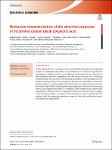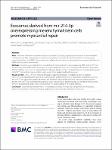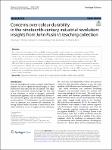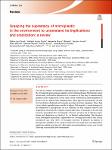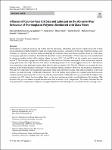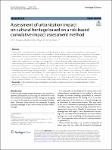Search
Author
- Manyk, T. (3)
- Murawski, K. (3)
- Baumgartner, Jörg (2)
- Guizani, Chamseddine (2)
- next >
Subject
Date issued
- 2023 (187)
Has File(s)
- true (187)
Search Results
Thermal barrier coatings are essential materials systems for insulating and protecting substrates exposed to high temperatures. In such systems, the heat transfer has three possible paths: conduction, convection and irradiation. The higher the operating temperature, the more important it is to control or protect against the radiative component, since the radiative heat flux becomes non-negligible. The radiation can be controlled by the use of ceramic-based photonic nanostructures, namely photonic crystals and photonic glasses, creating so-called reflective thermal barrier coatings. In this work, mullite inverse photonic glasses (PhG) have been produced by thermally induced reaction on sol–gel-based silica structures coated with nanometric films of Al2O3 by atomic layer deposition. T... |
In this paper, the electrical response of a carbon black polylactic acid 3D printed polymer is characterised in detail by a combination of advanced experimental techniques at different scale lengths. The electrical properties as a function of the temperature become repeatable after the second heating cycle, exhibiting different trends as a function of the printing parameters. Joule heating and oven-heating techniques have been compared, showing the advantages of the Joule heating method to maintain electrical conductivity due to the lower thermal inertia. Small-Angle X-Ray Scattering has been employed to discern the underlying physics, showing the crucial role of crystallinity, filler dispersion and carbon black aggregates to form an effective segregated conductive network. |
Exosomes are known as nanovesicles that are naturally secreted, playing an essential role in stem-mediated cardioprotection. This study mainly focused on investigating if exosomes derived from miR-214 overexpressing mesenchymal stem cells (MSCs) show more valid cardioprotective ability in a rat model of acute myocardial infarction (AMI) and its potential mechanisms. |
The numerous new pigments that gradually became available to artists during the nineteenth-century Colour Revolution were received with contrasting attitudes. The initial enthusiasm for new chromatic possibilities was soon nuanced by concerns about the stability and performance of industrial materials. This study focuses on the work of John Ruskin, the famous art critic of Victorian England, whose artistic production was as impressive as his penmanship. Archival research into nineteenth-century literature is combined with material analyses with macro-XRF, XRD and FORS on a group of watercolours by Ruskin preserved at the Ashmolean Museum to determine his attitude towards pigment stability. |
The poor wettability of cemented carbides by molten metals as well as the different material properties compared to steel makes thermal joining process challenging. In this regard, innovative ultrasonic-assisted induction brazing is capable of joining the materials quickly, cost-effectively and without using environmentally hazardous fluxes. Instead, the oxide scales are broken up within the joining process due to ultrasonic-induced cavitation in the molten filler alloy and hence promote the wetting. However, since the use of ultrasound in brazing steel/cemented carbide joints is still insufficiently investigated, there is still a need to explore the fundamental influences of ultrasound on the brazing process. In this work, the effect of ultrasound on the microstructure of the braze... |
Over the last century, accumulation of microplastic has emerged as a greater threat to the environment, plants, microorganisms and even human beings. Microplastics can be intentionally produced for industries such as cosmetics, or they may be unintentionally generated from degradation of bulk plastic debris. Furthermore, mismanagement of plastic waste is a major source of microplastics. When ingested, microplastics can alter several physical, chemical and biological processes in living organisms. Thus, their toxicity silently spreads its roots into the biosphere. Unfortunately, current strategies for the elimination of microplastics are not sufficient for their complete removal and degradation. Therefore, the adoption of green innovative technologies is the first step toward a micro... |
Thermoplastic composite materials are widely used for aerospace, automobile and structural applications due to their good combination of high strength to weight ratio and specific modulus. Combined with the ease of melt processing, good resistance to corrosion, low friction, and noise damping are attributes which make them a popular choice in a wide range of emerging applications. Random, short-fibre, E-glass fibre reinforced Polyamide 6 (PA6) composites were manufactured by injection moulding in three different fibre volume fractions (25%, 33% and 50%) and the samples were scanned using micro-CT. The tribological properties of PA6 and glass fibre reinforced PA6 were investigated in the abrasive wear mode by using a pin-on-disc test setup. |
Urbanization is inevitable in both developing and developed countries. However, this growth and transformation of the urban area can pose a significant threat to urban cultural heritage, which is a sensitive component of the urban environment. As cities modernize and change, a risk of irreparable loss of cultural heritage exists. Therefore, taking steps to protect and preserve these sites for posterity is crucial. To better protect urban cultural heritage, decision-makers must rapidly assess the impact of urbanization on cultural heritage while maintaining a balance between cultural heritage preservation and urban growth. This study developed a risk-based cumulative impact assessment (CIA) method that integrates a set of quantifiable indicators to address these issues. |
The present work investigates programmable auxetic surfaces and how they can be enabled to achieve a general surface shape upon external control. To actively generate target geometries from an initial geometry, a process of non-uniform expansion or contraction as well as an alteration of local curvatures are necessary. This implies the alignment of a multiplicity of control factors. The present work suggests that auxetic mechanisms hold a high potential to achieve and simplify such alignments. As a key principle for achieving defined target forms and the required shape transitions, the study identifies the modification of the local scaling factor and the Gaussian curvature of plane surfaces. Within this work, such active surfaces are created utilizing multi-layered auxetic tessellat... |
Carbon is a well known austenite stabiliser and can be used to alter the stacking fault energy and stability against martensitic transformation in medium Mn steels, producing a range of deformation mechanisms such as the Transformation Induced Plasticity (TRIP) or combined Twinning and Transformation Induced Plasticity (TWIP + TRIP) effects. However, the effect of C beyond quasi-static tensile behaviour is less well known. Therefore, two medium Mn steels with 0.2 and 0.5 wt pct C were designed to produce similar austenite fractions and stability and therefore tensile behaviour. These were processed to form lamellar and mixed equiaxed + lamellar microstructures. The low C steel had a corrected Charpy impact energy (KV10
) of 320 J cm−2
compared to 66 J cm−2
in the high C steel d... |


